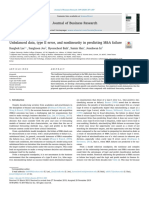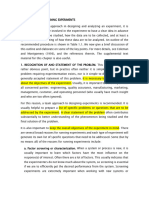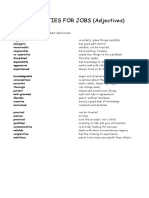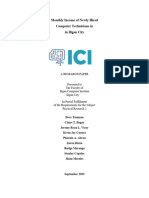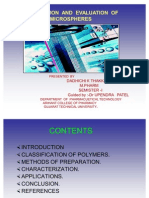(A) Experiment Vs Observational Studies/Sample Survey: ESGC 6112 - Experimental Design - Lecture 1
(A) Experiment Vs Observational Studies/Sample Survey: ESGC 6112 - Experimental Design - Lecture 1
Uploaded by
ragunatharaoCopyright:
Available Formats
(A) Experiment Vs Observational Studies/Sample Survey: ESGC 6112 - Experimental Design - Lecture 1
(A) Experiment Vs Observational Studies/Sample Survey: ESGC 6112 - Experimental Design - Lecture 1
Uploaded by
ragunatharaoOriginal Description:
Original Title
Copyright
Available Formats
Share this document
Did you find this document useful?
Is this content inappropriate?
Copyright:
Available Formats
(A) Experiment Vs Observational Studies/Sample Survey: ESGC 6112 - Experimental Design - Lecture 1
(A) Experiment Vs Observational Studies/Sample Survey: ESGC 6112 - Experimental Design - Lecture 1
Uploaded by
ragunatharaoCopyright:
Available Formats
ESGC 6112 – Experimental Design – Lecture 1
(A) Experiment vs Observational Studies/Sample Survey
Observational studies/sample survey:
(1) data collected under conditions which already exist.
(2) e.g. Max temp, total rainfall, annual income of certain
households, number of telephone calls in a day
(3) Finite population
Experiment:
(1) to see how does the response/output change when we
deliberately changes the conditions.
(2) E.g. In a chemical process change the pressure/temperature, in
an agricultural experiment change the dose of fertilizer; in an
office change the air-cond temperature and note the
productivity; in a pharma experiment, change the level of a
carcinogenic drug and count the number of tumors.
(3) Infinite population of response.
(B) What is Experimentation
Experimentation is part of everyday life. Eg.: Will leaving 30
minutes earlier than usual in the morning make it easier to find a
legal parking space at work? How about 20 minutes earlier? Or
only 10 minutes earlier? – We’re frequently interested to learn if
and how some measure of performance is influenced by our
manipulation of the factors that might affect that measure.
An Experiment is an inquiry in which an investigator chooses the
levels (values) of one or more input, or independent, variables, and
observes the values of the output, or dependent, variable(s).
The purpose of experimental activity is to lead to an understanding
of the relationship between input and output variables, often to
further optimize the underlying process. That is to (i) improve
process yield; (ii) reduce variability; (iii) reduce development time,
(iv) reduce overall cost, etc
An experimental design is the aggregation of independent
variables, the set of levels of each independent variable, and the
combination of these levels that are chosen for experimental
purposes.
The core of an experimental design is to answer the 3-part question:
- Which factors should we study?
- How should the levels of these factors vary?
- In what way should these levels be combined?
(C) Guidelines for Designing Experiments
1. Recognition of and statement of the problem
- Develop objectives of experiment & overall objective
- List of specific problems/questions to be addressed & relate
directly to overall objectives
2. Selection of the response variables/dependent variables/output
variables
- ensure that the right performance measure is chosen – the
quantity that is really the important one; eg. In an experiment to
help develop a better cover for a specialty catalog – choice of
dependent variable is the sales volume that results rather than
the brightness of the cover.
- translate output variables to measurable quantities; eg:
subjective – how do you measure taste or appearance; units of
measurement
3. Choices of factors (input or independent variables), level and range
- cause-and-effect diagrams to identify factors affecting the
dependent variable;
- factors such as people factors, equipment factors, environmental
factors, method factors, and materials factors etc…
- minimize the number of factors under study – a higher number
of factors under study is associated with an increased size of an
experiment, this in turn increases the cost and time of the
experiment.
- If the response of the dependent variable to the factor is linear, 2
levels of the factor will suffice, but if the response is non-linear,
one needs more than two – if the factor is measured on a
numerical scale, 3 levels will suffice.
- Identify potential synergy (interaction) between different
factors:
An interaction, or synergy, is the combined effect of factors
considered separately. – the total is > the sum of the parts.
4. Choices of experimental design
- Sample size (no. of replicates)
- Suitable run order
- factorial designs – the experiment comprises varying
combinations of levels of factors, are in general vastly superior
to one-at-a-time designs, in which the level of each factor is
varied, but only one factor at a time.
- Determine how much “fractioning” is appropriate – When there
are large number of combinations of levels of factors, inevitably
only a fraction of them are actually run. Determining which
fraction is appropriate, and the best subset of combinations of
levels of factors to make up this fraction, is a large part of the
skill in designing experiments.
- Consideration of blocking, which is controlling factors that may
not be of primary interest but that if uncontrolled will add to the
variability in the data and perhaps obscure the true effects of the
factors of real interest.
5. Performing the experiment
- Monitor the process carefully
- Pilot/trial run
- The order of running the combinations of levels of factors
should be random.
6. Statistical analysis of the data
- Able to tell whether an observed difference is indicating a real
difference – go through hypothesis testing.
- ANOVA – analysis of variance – whether the level of a factor
(or interaction of factors) influences the value of the output
variable.
7. Conclusion and recommendation
- Verify the conclusions. If we are attempting to determine
which factors affect the dependent variable, and to what degree,
our analysis could include a determination as to which
combination of levels of factors provides the optimal values of
the dependent variable.
- Evaluates whether the results make sense – economic
evaluation (or cost/benefit analysis) of the results.
(D) Experiment-Design Applications in Management
1. Corporate Environmental Behavior
2. Supermarket Decision Variables
3. Financial Services Menu
4. The Qualities of a Superior Motel
5. Time and East of Seatbelt Use: A Public Sector Example
6. Emergency Assistance Service for Travelers
You might also like
- Practical Design of Experiments: DoE Made EasyFrom EverandPractical Design of Experiments: DoE Made EasyRating: 4.5 out of 5 stars4.5/5 (7)
- Study Guide for Practical Statistics for EducatorsFrom EverandStudy Guide for Practical Statistics for EducatorsRating: 4 out of 5 stars4/5 (1)
- Unbalanced Data, Type II Error, and Nonlinearity in Predicting M&A FailureDocument17 pagesUnbalanced Data, Type II Error, and Nonlinearity in Predicting M&A FailureАнна ДарьеваNo ratings yet
- Guidelines For Designing Experiments 1Document9 pagesGuidelines For Designing Experiments 1st.nostudioNo ratings yet
- 1design (Cha1) 2012-1Document7 pages1design (Cha1) 2012-1gebremaryamzeleke081No ratings yet
- 4 DOE Elements of SuccessDocument2 pages4 DOE Elements of SuccesscvenkatasunilNo ratings yet
- 5 DoeDocument21 pages5 DoeHendrik V SihombingNo ratings yet
- DOEs Material IDocument43 pagesDOEs Material ImereninnasNo ratings yet
- Design of ExperimentsDocument42 pagesDesign of ExperimentsR.BALASUBRAMANINo ratings yet
- Design of Experiments (DOE) : - Planning Phase - Designing Phase - Conducting Phase - Analyzing PhaseDocument12 pagesDesign of Experiments (DOE) : - Planning Phase - Designing Phase - Conducting Phase - Analyzing PhaseYang Yew RenNo ratings yet
- Design of Experiments by Dr. Majid Majeed Akbar: Institute of Chemical Engineering & Technology University of The PunjabDocument19 pagesDesign of Experiments by Dr. Majid Majeed Akbar: Institute of Chemical Engineering & Technology University of The PunjabTamoor TariqNo ratings yet
- Design of Experiments With Several FactorsDocument20 pagesDesign of Experiments With Several FactorsJames PalisocNo ratings yet
- What Is Design of Experiments (DOE) ?Document8 pagesWhat Is Design of Experiments (DOE) ?karthikspeedNo ratings yet
- Design Experiments For MQL1Document15 pagesDesign Experiments For MQL1VishalDabhadeNo ratings yet
- Finals StatsDocument16 pagesFinals Statskara mNo ratings yet
- MS Excel NNNDocument41 pagesMS Excel NNNNARENDERNo ratings yet
- Lectue Note CH 1-4Document41 pagesLectue Note CH 1-4Aba MachaNo ratings yet
- Designing and Conducting LaboratoryDocument20 pagesDesigning and Conducting LaboratoryevvrvrvrNo ratings yet
- Pradeep Krishnan - Project ReportDocument36 pagesPradeep Krishnan - Project ReportSiva BalanNo ratings yet
- Experimental DesignDocument14 pagesExperimental DesignAtul DwivediNo ratings yet
- Ch08 - Design of ExperimentsDocument19 pagesCh08 - Design of ExperimentsAthul JohnNo ratings yet
- EIAR ManualDocument175 pagesEIAR ManualWondimeneh TayeNo ratings yet
- Experimental ResearchDocument4 pagesExperimental ResearchDebbie Marie BaisNo ratings yet
- EARG - Factorial DesignDocument13 pagesEARG - Factorial DesignGie_Anggriyani_4158No ratings yet
- Design of ExperimentsDocument37 pagesDesign of ExperimentsImtiaz Alam MayoNo ratings yet
- Resaerch Logy Set-1Document8 pagesResaerch Logy Set-1kalpesh18887No ratings yet
- Design and Analysis of ExperimentsDocument6 pagesDesign and Analysis of ExperimentsAnonymous SCI5W4qYNo ratings yet
- Definations DesignDocument9 pagesDefinations DesignHammad AliNo ratings yet
- Unit 5Document11 pagesUnit 5K R SAI LAKSHMINo ratings yet
- Cap 7Document32 pagesCap 7Jhonatan LeandroNo ratings yet
- Chap2 Planing ExperimentDocument4 pagesChap2 Planing ExperimentErik NgNo ratings yet
- Introductory ExampleDocument11 pagesIntroductory ExampleChristianAslanNo ratings yet
- Printed AHS 2307 Experimental Design NotesDocument43 pagesPrinted AHS 2307 Experimental Design NotesBancy k.No ratings yet
- Chapter 1Document29 pagesChapter 1tain mounNo ratings yet
- DAE1Document32 pagesDAE1ABHISHEK KUMAR CHAUHANNo ratings yet
- Blocking, - Confounding, and - Fractional Factorial DesignsDocument87 pagesBlocking, - Confounding, and - Fractional Factorial DesignsTeflon SlimNo ratings yet
- Design of ExperimentsDocument9 pagesDesign of ExperimentsMohammad AjlouniNo ratings yet
- Module AGRI 214Document55 pagesModule AGRI 214Queenie Gwyneth MananganNo ratings yet
- Chap4 - EXPERIMENTAL DESIGNDocument31 pagesChap4 - EXPERIMENTAL DESIGNHưng PhạmNo ratings yet
- Design of Experiments UpdatedDocument70 pagesDesign of Experiments Updatedmaragathamani21No ratings yet
- Chapter 1 Design of ExperimentDocument9 pagesChapter 1 Design of ExperimentmereninnasNo ratings yet
- Step by Step How To Write The IaDocument11 pagesStep by Step How To Write The IaMayur VanjaniNo ratings yet
- Experimental Design and Analysis of VarianceDocument66 pagesExperimental Design and Analysis of Variancealtheajade jabanNo ratings yet
- 6 Experimental Design Lectrue - 24.9.2022 PDFDocument46 pages6 Experimental Design Lectrue - 24.9.2022 PDFSahethi100% (1)
- Guidelines For Designing ExperimentsDocument13 pagesGuidelines For Designing ExperimentsupenderNo ratings yet
- 5 ImproveDocument51 pages5 Improvepm9286vNo ratings yet
- HASTS212 Lecture 1Document31 pagesHASTS212 Lecture 1Carl UsheNo ratings yet
- Design of ExperimentsDocument26 pagesDesign of ExperimentsGaddipati Mohankrishna100% (1)
- Research Method in Technology (It542) Assignment 2 Section IiDocument14 pagesResearch Method in Technology (It542) Assignment 2 Section Iimelesse bisemaNo ratings yet
- Role of Statistics: in Mathematical ModellingDocument7 pagesRole of Statistics: in Mathematical ModellingKumar ShantanuNo ratings yet
- 1) Explain The Four Types of Experimental DesignsDocument12 pages1) Explain The Four Types of Experimental DesignsnikhilNo ratings yet
- Jomo Kenyatta University of Agriculture and TechnologyDocument5 pagesJomo Kenyatta University of Agriculture and TechnologysolocheruicNo ratings yet
- Cap 3Document72 pagesCap 3Jhonatan LeandroNo ratings yet
- Designing Experiments An OverviewDocument6 pagesDesigning Experiments An OverviewNagarajan.NNo ratings yet
- Lecture Three: Elements of Research DesignDocument22 pagesLecture Three: Elements of Research DesignEden Dela CruzNo ratings yet
- Review of Experimental Design in Analytical ChemistryDocument16 pagesReview of Experimental Design in Analytical ChemistrybetelgueseNo ratings yet
- Resume Research Uma SekaranDocument6 pagesResume Research Uma SekaranKakiya IndonesiaNo ratings yet
- Chapter One 1.1 Background of The Study The Experimental Design Is The Design of Any Task That Aims To Describe orDocument7 pagesChapter One 1.1 Background of The Study The Experimental Design Is The Design of Any Task That Aims To Describe orOmotayo AbayomiNo ratings yet
- Supplemental Material D. Montgomery S12-1. Guidelines For Planning ExperimentsDocument9 pagesSupplemental Material D. Montgomery S12-1. Guidelines For Planning ExperimentsRago Ramirez GzzNo ratings yet
- Statistical Method from the Viewpoint of Quality ControlFrom EverandStatistical Method from the Viewpoint of Quality ControlRating: 4.5 out of 5 stars4.5/5 (5)
- Faber Medi-Serve SDN BHD: Privatisation of Hospital Support Services Ministry of Health, MalaysiaDocument7 pagesFaber Medi-Serve SDN BHD: Privatisation of Hospital Support Services Ministry of Health, MalaysiaragunatharaoNo ratings yet
- Hospital Location CodeDocument47 pagesHospital Location CoderagunatharaoNo ratings yet
- Faber Medi-Serve SDN BHDDocument6 pagesFaber Medi-Serve SDN BHDragunatharaoNo ratings yet
- Faber Medi-Serve SDN BHDDocument6 pagesFaber Medi-Serve SDN BHDragunatharaoNo ratings yet
- Equipment Inventory Data: Air Conditioners & Ahu'S: Belts FiltersDocument2 pagesEquipment Inventory Data: Air Conditioners & Ahu'S: Belts FiltersragunatharaoNo ratings yet
- 1 Statistical Modeling and Blind Source Separation: H. AttiasDocument34 pages1 Statistical Modeling and Blind Source Separation: H. AttiasragunatharaoNo ratings yet
- Asset List: Tools & Equipment For Operation (Proposed To Be Purchase)Document3 pagesAsset List: Tools & Equipment For Operation (Proposed To Be Purchase)ragunatharaoNo ratings yet
- Assignment 2Document8 pagesAssignment 2ragunatharaoNo ratings yet
- ESGC6112 - Lecture 8 (Chapter 11 - PG 311) Two-Level Fractional-Factorial DesignsDocument19 pagesESGC6112 - Lecture 8 (Chapter 11 - PG 311) Two-Level Fractional-Factorial DesignsragunatharaoNo ratings yet
- 4.1 Introduction To Studying Two Factors: ESGC 6112: Lecture 4 Two-Factor Cross-Classification DesignsDocument14 pages4.1 Introduction To Studying Two Factors: ESGC 6112: Lecture 4 Two-Factor Cross-Classification DesignsragunatharaoNo ratings yet
- 7.1 Simple Confounding: ESGC6112 - Lecture 7 Confounding/Blocking in 2 Designs (PG 289)Document13 pages7.1 Simple Confounding: ESGC6112 - Lecture 7 Confounding/Blocking in 2 Designs (PG 289)ragunatharaoNo ratings yet
- REGISTERED PV SERVICE PROVIDER v4.1Document8 pagesREGISTERED PV SERVICE PROVIDER v4.1ragunatharaoNo ratings yet
- Guidelines On E-Application For Ica10Document1 pageGuidelines On E-Application For Ica10ragunatharaoNo ratings yet
- RPVI Manual FormDocument5 pagesRPVI Manual FormragunatharaoNo ratings yet
- Cell DifferentiationDocument26 pagesCell DifferentiationQusai Haimone100% (1)
- SEM 3-Week 03 Task Assignment My Life AchievementsDocument2 pagesSEM 3-Week 03 Task Assignment My Life AchievementsSergio Niquen BcsNo ratings yet
- Learning Team Aet562 - Self-Guided Social Media Training ManualDocument18 pagesLearning Team Aet562 - Self-Guided Social Media Training Manualapi-646128900No ratings yet
- DWITIYA SOPAN LogDocument76 pagesDWITIYA SOPAN Logasmiyaaslam062007No ratings yet
- The Schoharie Creek BridgeDocument28 pagesThe Schoharie Creek Bridgesanthu256100% (1)
- QUALITIES FOR JOBS (Adjectives) : Join The Adjectives With Their DefinitionDocument4 pagesQUALITIES FOR JOBS (Adjectives) : Join The Adjectives With Their DefinitionZahariuc AndreeaNo ratings yet
- Practice Occupational Health and Safety ProceduresDocument97 pagesPractice Occupational Health and Safety ProceduresNeolie Laturnas Jr.100% (1)
- Ian W - BoydDocument1 pageIan W - BoydMichael EkubaselasieNo ratings yet
- ME 2204 Fluid Mechanics and Machinery TEST (I Unit) QNDocument2 pagesME 2204 Fluid Mechanics and Machinery TEST (I Unit) QNVignesh VickyNo ratings yet
- Monthly Income of Newly Hired Computer TechniciansDocument11 pagesMonthly Income of Newly Hired Computer Technicianshayusa8214No ratings yet
- UntitledDocument357 pagesUntitledThabo MatshayaNo ratings yet
- Information:: YellowDocument5 pagesInformation:: YellowAkhosh KrishnaNo ratings yet
- Ultrasound Therapy Ii: Aditya Johan .R, M.FisDocument18 pagesUltrasound Therapy Ii: Aditya Johan .R, M.FisKamu HebatNo ratings yet
- BPS Question BankDocument6 pagesBPS Question Bankthegamepalace10No ratings yet
- Morocco Ducted Inverter - FA SeriesDocument34 pagesMorocco Ducted Inverter - FA SeriesAbdellahJrhaidarNo ratings yet
- A Discrete Event Simulation Model For Reliability Modeling of A Chemical PlantDocument5 pagesA Discrete Event Simulation Model For Reliability Modeling of A Chemical PlantAhmad BuchoriNo ratings yet
- Module 1 LangCulSocDocument25 pagesModule 1 LangCulSocdesiree viernesNo ratings yet
- Albumin - BCG PDFDocument2 pagesAlbumin - BCG PDFHamed Alsalhy100% (1)
- OPT B1plus T2M Unit 5 WorksheetDocument1 pageOPT B1plus T2M Unit 5 Worksheetwefg3qaw4sNo ratings yet
- AMPHOSOL1CDocument2 pagesAMPHOSOL1CJosé Manuel Martínez cedilloNo ratings yet
- Formulation and Evaluation of MicrospheresDocument45 pagesFormulation and Evaluation of MicrospheresThakkar Dadhichi KiritbhaiNo ratings yet
- Product Overview: in Row & in Rack Cooling SystemsDocument26 pagesProduct Overview: in Row & in Rack Cooling SystemsJose Navarro NavarroNo ratings yet
- Thin Lenses: Prepared By: Jenno S. Lantaya, OdDocument31 pagesThin Lenses: Prepared By: Jenno S. Lantaya, OdKwenzie FortalezaNo ratings yet
- Mid Term Date Sheet 2022 Fall Foc IubDocument53 pagesMid Term Date Sheet 2022 Fall Foc IubHuzaifaNo ratings yet
- Med Midterm Exam 2nd Sem Sy 2021 2022Document2 pagesMed Midterm Exam 2nd Sem Sy 2021 2022dianne sulaNo ratings yet
- Year 6 - Reasoning - Autumn 2018Document16 pagesYear 6 - Reasoning - Autumn 2018MJNo ratings yet
- Historicism and Lacanian Theory Dylan EvansDocument6 pagesHistoricism and Lacanian Theory Dylan EvansMax ElskampNo ratings yet
- Week-1, Quarter 1-Visualizes-and-represents-numbers-from-0-to-100-using-a-variety-of-materialsMINS-Ia1.1Document11 pagesWeek-1, Quarter 1-Visualizes-and-represents-numbers-from-0-to-100-using-a-variety-of-materialsMINS-Ia1.1atz Kusain100% (1)
- MCQ Probability Class 12Document5 pagesMCQ Probability Class 12jayNo ratings yet


